In U.S., 38% of adults and 17% of kids are now obese, CDC study says

How do government agencies, private foundations, industry groups and professional societies squander hundreds of millions of dollars? By trying to fight Americaâs obesity epidemic.
Two new studies show that the best efforts of all these players â as well as schools, churches and individual healthcare providers â have largely failed to keep most Americans from getting fatter.
One report finds that 35% of men and 40% of women were obese as of 2014, the most recent year for which data were available. The other says that 17% of children and teens were obese as well, including nearly 6% who were morbidly obese.
See the most-read stories in Science this hour »
Both studies appear in Tuesdayâs edition of the Journal of the American Medical Assn.
âThe news is neither good nor surprising,â two of the journalâs top editors wrote in a pointed editorial. Still, the pair wrote, the findings serve as a powerful reminder of âthe unrelenting challenge of obesity.â
Both studies are based on data collected as part of the National Health and Nutrition Examination Survey, an ongoing project from the Centers for Disease Control and Prevention.
Year after year, trained professionals measure the height and weight of thousands of volunteers from around the country. Those measurements are used to compute body mass index, an imperfect but useful measure of health that is highly correlated with fatness. A BMI between 18.5 and 24.9 is considered ânormal.â People in the 25 to 29.9 range are classified as âoverweight,â and anyone above 30 is âobese.â (You can calculate your own BMI here.)
Based on data from 2,638 men and 2,817 women, researchers from the CDCâs National Center for Health Statistics calculated that 38% of American adults were obese as of 2014, up from 34% in 2006. The prevalence of obesity increased among women during that period, but not men.
The odds of being obese fluctuated with age. The researchers found that 41% of adults in their 40s and 50s were obese, compared with 34% of adults in their 20s and 30s and 39% of adults ages 60 and older.
There were also differences based on race and ethnicity. At one end of the spectrum were Asian Americans, 13% of whom were obese. At the other end were African Americans, 48% of whom were obese. In between were Latinos (43%) and whites (36%).
In another group of calculations, the researchers determined that 5.5% of men and 9.9% of women were morbidly obese, with a BMI over 40.
The definitions are different for children and teens. Those who have a BMI at or above the 95th percentile for kids of the same age and gender on the CDCâs growth charts are considered obese; if their BMI is at least 20% higher than that cut-off, they are counted as morbidly obese.
The younger the child, the lower the risk of obesity, according to a second study by the same group of researchers and two additional CDC colleagues. For instance, 9% of children between the ages of 2 and 5 were obese, compared with 18% of kids between the ages of 6 and 11 and 21% of teens ages 12 to 19.
Compared to white children, the odds of obesity were 34% higher for black children and 48% higher for Latino children, the researchers found. Asian American children were 43% less likely than whites to be obese.
Parentsâ education also seems to play a role. Compared to kids living in homes headed by someone who attended or graduated from college, those whose parent or guardian had dropped out of high school were 41% more likely to be obese, and those whose parent or guardian had only a high school degree were 61% more likely to be obese.
Looking back all the way to 1988, the researchers found that the prevalence of obesity among the youngest group of kids rose until 2004, then began to decrease. It kept rising among 6- to 11-year-olds until 2008 before leveling off. For teens, the prevalence of obesity rose continuously for 26 years.
All of these disheartening statistics leave little reason for optimism, Dr. Jody Zylke and Dr. Howard Bauchner, both pediatricians, wrote in the JAMA editorial. Programs aimed at improving nutrition labels, encouraging diners to make more healthful choices and encouraging Americans to exercise have done little to improve the situation, they wrote. Nor is it likely that any drug or medical procedure will solve the problem, they added.
That means the best strategy is to focus on preventing obesity in the first place, Zylke and Bauchner wrote, even though prevention campaigns to date have ânot been highly successful.â
The pair also called on those who have spent so much money on programs that have accomplished so little to start working with their adversaries â the companies that produce the calorie-laden food so many Americans love to eat.
âThe food and restaurant industries may be the sector of society with the greatest potential to affect the obesity epidemic in a reasonable time frame,â they wrote. âThese industries have been good at developing and successfully marketing unhealthy foods; perhaps it will be possible for them to develop and market healthy foods.â
MORE IN SCIENCE
Why the FDA wants food manufacturers to put one-third less sodium in their products
Part microbe, part machine: Bionic leaf sucks up carbon dioxide as it makes liquid fuel
Dogs are so great that humans domesticated them not once, but twice




